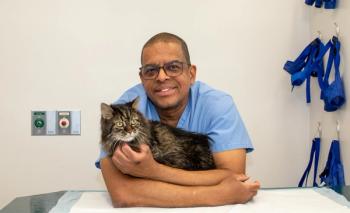
Key considerations for chemotherapy dosing
Lindsay Hallman, CVT, CCMT, VTS (Oncology), and Katelyn McDonald, CVT, VTS (Oncology), discuss clinical administration of oncology therapy, in a dvm360 interview.
Chemotherapy administration can pose challenges for the veterinary team, clients and patients. In a dvm360® interview, Lindsay Hallman, CVT, CCMT, VTS (Oncology), and Katelyn McDonald, CVT, VTS (Oncology), veterinary technician specialists at Mount Laurel Animal Hospital in New Jersey, discussed dosing, patient behavior, and adverse effects with chemotherapy as well as other aspects of administration. In this video, showing part of the interview, they address some dosing considerations to help patients achieve positive outcomes.
RELATED VIDEO:
The following is a transcript of the video, lightly edited for clarity:
dvm360: What are some considerations for dosing veterinary patients with chemotherapy?
Lindsay Hallman, CVT, CCMT, VTS (Oncology): The doses that we're using in animals are much, much, much smaller than what we're using in humans. In human oncology, what they're looking for is quantity, not quality, and we're not going to do that to an animal. One, they didn't sign up to be sick for a year. And two, for people, it's okay to lose that year, because you might get 30, 40, 50 years on the back end. Unfortunately, I wish that our companion animals would get 30 years on the back end, but we know they're not going to. So we are more looking for quality. So we dose our chemotherapy and we check blood work really frequently to make sure that we walk this really fine gray line where we're keeping the cancer at bay, hopefully putting them into remission, but not making them sick.
Katelyn McDonald, CVT, VTS (Oncology): We do have a dose range for all of these medications. We stereotypically start out on the high end of dose ranges, because obviously we want to challenge the cancer as much as possible. Our objective is to try to treat the cancer as aggressively as we can, but not to the detriment of our patient. And what that allows us to do is if we have a patient that does experience significant enough side effects to impact their quality of life, because, as Lindsay said, that's our goal. If we are making them sick, we're not doing it right. What we can do is we can do dose reductions of that chemotherapy by about a 10% per dose reduction rate, typically to start. So we would just shave a hair off of their next dose in order to alleviate them from having those side effects that they had. So they can still get the benefit of a treatment that's efficacious, but not with those side effects.
RELATED VIDEO:
Newsletter
From exam room tips to practice management insights, get trusted veterinary news delivered straight to your inbox—subscribe to dvm360.






